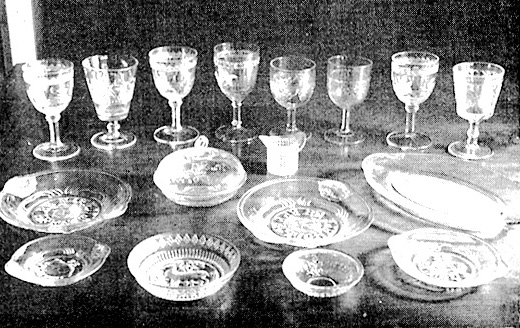|
The
Iowa City Glass making plant was located north of Kirkwood Avenue beside the
Rock Island tracks.
Many
different pieces were produced from stemmed goblets to platters and bowls,
even marbles.
By Bob Hibbs Local Historian
A
post-Civil War industrial boom brought several new industries to Iowa City and
Johnson County, including a glass manufacturing plant which produced a variety
of pieces highly sought by collectors today.
The
nemesis is that others produced nearly identical pieces – sometimes from the
same molds – making absolute identification as “Iowa City Glass” nearly
impossible unless accompanied by original wrappings or written certification.
Identifiable pieces can command several hundred dollars each; truly rare ones
even more.
The
glass was made beginning in early summer 1882 for a period of about 15 months
before the plant was closed and its limited assets distributed among
creditors. Several railroad cars filled with finished glassware were emptied
by creditors for nickels of what they were due. Pieces were given away as
premiums by grocers.
The
plant was located along Kirkwood Avenue at Maiden Lane, beside the railroad
tracks. During recent years it served as site to Eicher Greenhouse, and now a
tire shop.
From
1890 until a tannery fire in 1898, the former glass plant housed the highly
regarded Rate & Sons Glove Company factory, which during its long
existence also occupied two other locations and suffered two other major
fires.
The
Iowa City Flint Glass Manufacturing Company was incorporated April 30, 1880.
It bought its plant site two pieces from Catherine Sanders and S. Sharpless,
both on June 9, 1880. Among incorporators of the company were legendary local
banker and entrepreneur Ezekiel Clark and plant manager James Leighton, the
only one of 10 investors with experience with glass production.
Leighton,
born about 1849, had come to a glass factory at Keota in 1879 from Wheeling,
W.V., where he had been a glass blower. When
the Keota operation failed within a year, he moved on to Iowa City. He is the
probably source of some – perhaps most – of the molds used for products
here.
Sand
is by weight the principal ingredient of glass. The Iowa City operation was
based on the belief that sand from along the Iowa River a few miles south of
the plant could be shipped the short distance by rail, an extremely efficient,
reliable source.
However,
early glass from this sand had a tendency to “explode” or shatter as room
temperature changes caused gas bubbles to seek release from within the
finished product. Sand had to be shipped in from Indiana at considerable
expense, which proved financially disastrous. The plant was forced to poorer
quality products which didn’t prove marketable.
At
its peak, it employed about 150, many of whom came as experienced workers from
eastern states, some reportedly sent by competing glass operations as
saboteurs to cause the local plant difficulty. Tales claim many were a rough
lot who frequented a tavern on a site now serving the University of Iowa
engineering building. “Drunken brawls” were reportedly common.
The
definitive treatise on Iowa City Glass was written by Miriam Righter and
published in hard-cover form in 1961 and reissued later in soft-cover. It
remains a valuable source on the topic and collecting hobby it spawned. The
Righters, Miriam and UI band director husband Charles, resided in the Manville
Heights neighborhood of Iowa City a half century beginning during the 1940s.
Other
industries which grew or were established in Iowa City soon after 1865
included distilling, canning, weaving, knitting, and factories producing such
products as buttons, linseed oil, drugs, perfume, glucose sugar, jewelry and
cigars. A steel foundry was established at Lone Tree.
The
life cycle of these enterprises extended from a few years to a few decades,
some highly profitable for a time. Cigar manufacture extended well into the 20th
century, although, it, too, eventually went up in smoke, so to speak!
Next
Saturday:
Bunkers at the foot of engineering hill c1907.
Bob
Hibbs collects local postcards and researches history related to them. |
